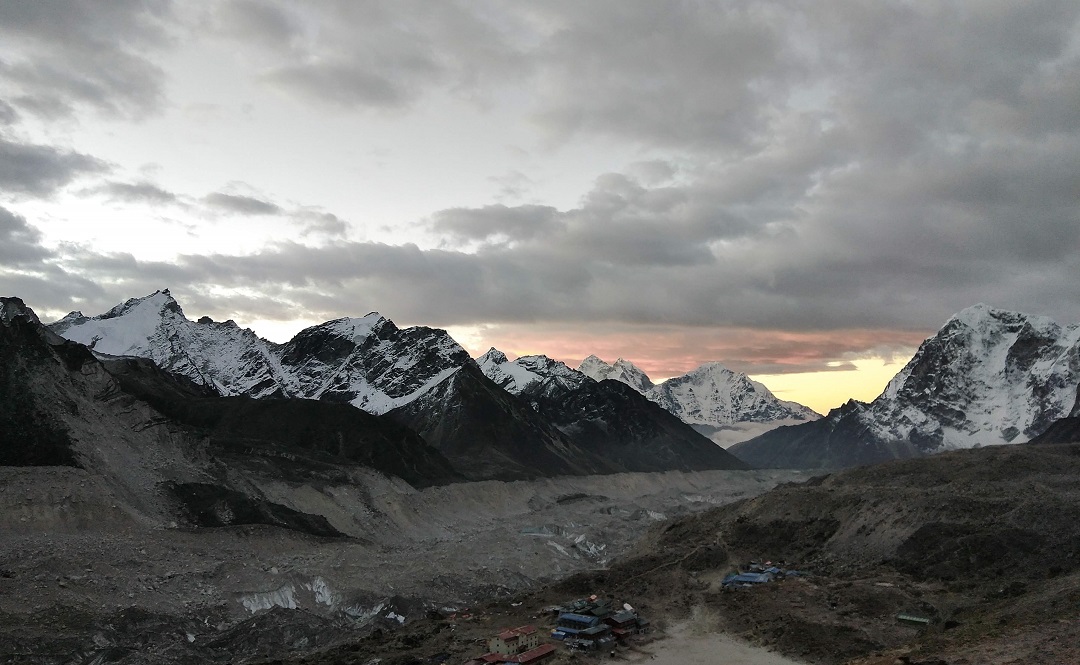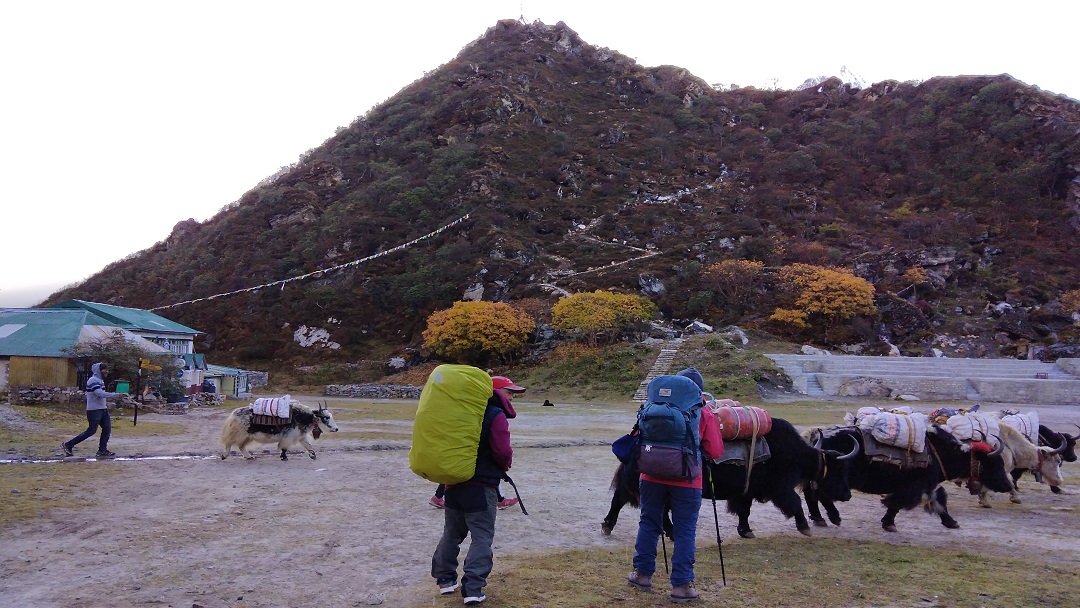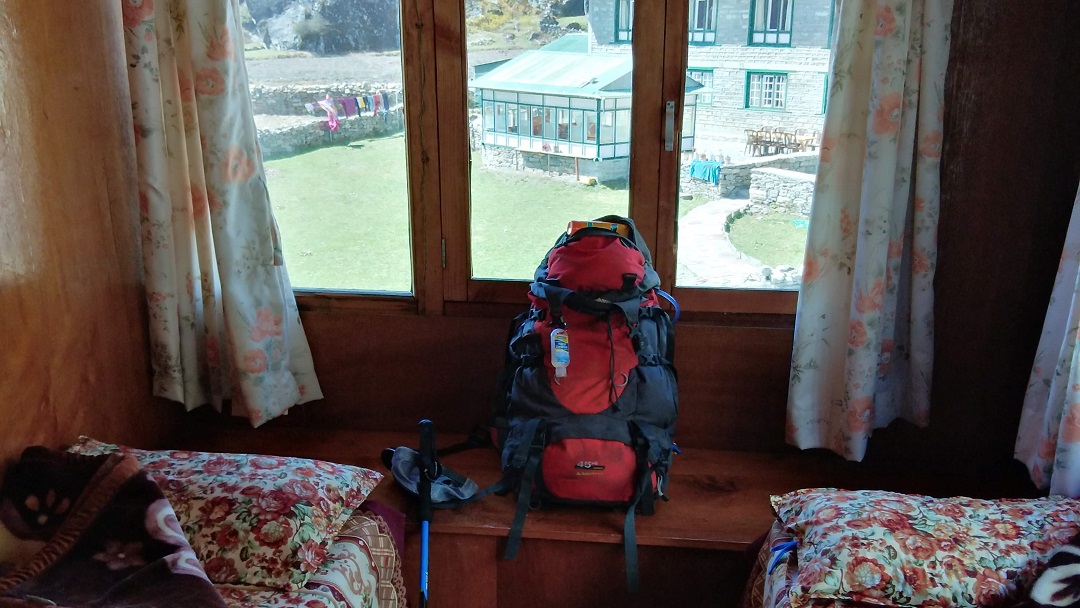
Everest Base Camp Trek is a rewarding experience only when you are prepared for everything the mountains have to offer. So here’s your comprehensive guide to pack your gears for the Everest Base Camp Trek.
Understanding the Weather and Seasons

As quoted by Sir Ranulph Fiennes- ‘There is no such thing as bad weather, only inappropriate clothing.’
Before packing, understanding the weather is crucial, so you know exactly what to expect. While you can go ahead in spring with a lighter backpack, the unforgiving winters weather means more layers, and sleeping bags. So here’s a monthly breakdown of weather in the Everest Region.
Jan | Feb | Mar | Apr | May | Jun | Jul | Aug | Sep | Oct | Nov | Dec
How much weight can I carry for the trek?

The standard baggage allowance prescribed by the Airlines for Lukla flights is 10 kgs for the luggage and 5 kgs for the hand-carry. The rules aren’t too strict so you don’t have to be too precise/ they usually don’t penalize for small amounts over the limit. And if your backpack is heavier, you’ll be charged $1 for every extra kilo of weight at the airport counter.
Quick Tip: If you’re worried about your bag being heavy, wearing your heavy stuff like a trekking boot, fleece and down jacket is a smart choice.
Storing Luggage: Since you might not need everything you’ve packed during your trek, storing your luggage in the hotel in Kathmandu is a safe option. They don’t charge you extra as they have an incentive to get you stay on the return as well.
Can I buy gears in Kathmandu?
Yes. Thamel is filled with gear shops, camera stores, convenience stores, pharmacy, and mostly everything a trekker might need. Buying gears in Kathmandu will rid you of the hassle of carrying heavy luggage from your home country. There are authorized showrooms of brands like The North Face, Columbia, Quecha, Sherpa, etc. But most gears you see are the local brands with fake labels. Make sure you can tell The North Face from The North Fake. No matter what, these gears are reasonable and will also last you a trek or two.
However, if you want durable products and don’t mind the cost, go for the genuine brands from your home country. Also, don’t compromise on gear if you’re trekking during winters. And for trekking boots, make sure you bring your own and break in before the trek.
Can I rent gear in Thamel?
Yes, you can. Several stores offer gear rentals at a reasonable price in Thamel. It also makes sense to rent a sleeping bag and down jacket if you don’t use them a lot.
Shona’s and Sportswear International are some excellent places to rent gears as they both produce their products, and the quality is good.
Rental cost: USD 1 -2 a day per item

Is it a good idea to buy gear on the trail?
Lukla and Namche Bazaar are the trade hubs with a number of stores that sell clothes and all kinds of gears. Although they make a good alternative if you missed packing something or need to make an emergency purchase, they’re not your ideal option. The prices are costly, and choices are limited.
Even for snacks and toiletries, there are convenient stores up to Dingboche and Pheriche, but the price in the trails amounts double if not triple than in Kathmandu.
Do I need a Sleeping Bag for Everest Trek?

If we talk about the need, you can do without a sleeping bag if you’re not trekking during the winter (December/January/February). All the hotels, even in Lobuche and Gorakshep, provide you with blankets.
But since the blankets and sheets may not be washed frequently, most trekkers prefer to carry their sleeping bags. Also, if you haven’t pre-booked hotels, you are likely to end up at the hotel’s dining area during peak trekking seasons. So, in conclusion, you should consider carrying a sleeping bag.
Can I bring/ cook my own food on the EBC trek?
Practically, there’s no need at all. Everest Base Camp Trek is the most comfortable trek with tea houses throughout the trails. Besides, it is the policy of hotels that trekkers must eat at the hotel you’re staying. They earn more by selling food. So if anyone wants otherwise, hotels will charge them around USD 15-20 for the same rooms instead of USD 5.
Packing Checklist

Here’s a comprehensive list of anything and everything you will need for the Everest Base Camp Trek.
Clothing:
When it comes to clothing, layering is the key. You can either wear them individually and add or reduce them as per the need.
- Inner Thermals- Both top and bottom will make your trek that much more enjoyable.
- Middle Fleece Layer- A fleece is great for layering with wind/waterproof jacket for walking.
- Wind/Water Jacket- It’s your shell that you can layer with your mid-layers while walking in the trails. Make sure it is breathable and waterproof.
- Down Jacket- Mornings and evenings can be pretty chilly. It will make your stay at camp and short excursions that much more comfortable.
- Fleece pants- So you can remain warm and feel clean during the evenings.
- Trekking trousers- 2-3 pairs. Lightweight and loose. Having a good pant that protects the wind and is waterproof will a big plus.
- Trekking shirts- 3 pairs. Collared ones are better. Avoid cotton.
- Underwear- 4-6 should carry you through a two-three week trek.
- Buff- It can be used as a neck gaiter, headwear, mask, hairband, and a whole bunch of other ways. One of the best uses, however, is to cover your nose and mouth at high altitudes to hydrate your breath and avoid the cold, dry mountain air. Make sure to keep it rather loose around your nose, though, and your lungs will love you for it.
- Socks- 3 pairs are more than good enough. Make sure they are thick woolen ones. Merino wool works best
- Gloves- Make sure it is at least windproof.
- Woollen cap – Perfect in the evenings inside the hotels.
- Sun Hat/Baseball Hat- Great for protection from the sun when it is still warm enough.
Footwear:
- Trekking Boots- Lightweight, waterproof, ankle support, some toe room, and, most importantly, broken in. Do not compromise on your footwear. It can make or break the experience.
- Sandals- Great for giving your feet a breather during the evenings.
Other Essentials
- Backpack- If you’re carrying your own bag, a 70- liter Rucksack with pack cover is great. In case you’re hiring a porter, a 30-liter bag for yourself and a duffel bag for the porter should be good.
- Water bags/ Hydration Bottle- Get two bottles. One, either a camel bag or a bottle with a wide mouth for the trails. The other, for the high altitude or during the night in lodges that can take in hot water.
- Water filters or Water purification tablets- A SteriPEN, Lifestraw, or other water purification tablet. Choose your pick.
- Sunglasses with straps- Straps are necessary as sunglasses happen to be the one thing that people misplace most often while taking pictures or resting.
- Sleeping bag with liner- A light silk liner is good enough rather than the heavy fleece ones. Its main purpose is to protect you from lodge blankets that are washed at most twice a year.
- Trekking Poles- Your back and legs will love you for these, especially in downhill stretches.
- Head torch- Might need it to navigate your way to the toilets in hotels at night, and even during the Kalapathar hike if you go early in the morning.
- Waist Belt- A waist belt will help you access your money, passports, and energy bar without stopping.
- Swiss Army Knife- Pack it off in your luggage if you don’t want it confiscated at airports.
- Snacks- Carry some chocolate bars and nuts for a quick munch before lunch. Don’t carry too much as you can find them in lodges all along the trails.
Toiletries:
- Sunscreen- SPF 30-50 will be good enough. There is little point in going over that. However, make sure it is rated UVA in addition to UVB.
- Lip Balm- Moisturizing and SPF 30 necessary.
- Toilet paper- 2 rolls should be good enough.
- Toothbrush
- Toothpaste
- Shower Gel- Travel size or sachets ideal as you won’t be showering as much during a trek.
- Shampoo- Travel size of sachets are ideal.
- Towel- A small one will be more than good enough.
- Moisturizing cream- That cold, dry mountain air will take its toll on your skin.
- Hand sanitizer
- Feminine sanitary napkins- For women, if your periods are around the corner.
- Plastic Bags- 2 large ones, three small ones. Comes in very handy to put in your dirty laundry
Medication
- Povidone-Iodine cream- 1 tube
- Cotton- 1 roll
- Dressing Gauze- 5 pcs
- Crepe Bandage- 2
- Band-Aids- 10
- Dressing tape- 1
- Moleskin/ 2nd Skin- 1 packet
- Calamine- To aid in skin healing due to sunburns or chaffing.
- Paracetamol 300 mg- 20 tablets. For mild headaches.
- Ibuprofen 400 mg- 10 tablets. To relieve moderate to severe pain.
- Throat lozenges- 20. For cough and sore throat. It can be used preventively against the cold, dry mountain air.
- Decongestant- 10 tablets- For nasal congestion. Non-drowsy kinds like pseudoephedrine recommended.
- Antihistamine 10 tablets- For allergies.
- Antiemetic 10 tablets- To control vomit and nausea.
- Azithromycin 500 mg- 3 tablets. For bacterial diarrhea.
- Omeprazole 20 mg- 10 tablets. For gastric problems.
- Tinidazole 2 g- 3 tablets (500 mg- 12 tablets). For giardia and amoebic diarrhea.
- Acetazolamide (Diamox) 250 mg – 20 tablets. To aid acclimatization and AMS treatment.
- Nifedipine 60 mg – 10 tablets. To be used under expert supervision to prevent and treat HAPE.
- Loperamide 2 mg- 20 tablets. To control diarrhea.
Electronics and Entertainment:
- Mobile phone and charger
- Socket Adapter- Many sockets in Nepal are of Type C; that is, they have circular pins. It will be handy to have an adapter just in case.
- Camera with extra battery- One extra battery should be good as charging can sometimes be a bit of a hassle. Also, you cannot charge if you don’t have a charger. Do not forget that.
- Power bank: Charging devices are expensive, so consider carrying a power bank, preferably solar powered. Thank us later.
- Books/ Kindle- A trek is a perfect time to catch up on reading. However, it would be tough to finish more than two books in a single two-three week trek.
- Binoculars- Consider small and light ones unless watching wildlife is your main purpose.
- Diary and pen- for writing the perfect trek journal.
- Portable Games- Cards and Monopoly are good ways to kill time and socialize in the hotels.
Optional
- Raincoat/ Poncho- Although it doesn’t rain higher up, you should consider taking one depending on the month you’re trekking for lower altitudes.
- Kit Bag and lock- If you plan to hire a porter, a kit bag comes in handy. Make sure you get a lock too. Combination ones are easier.
- Sim card- Ncell network works decently up to Pangboche. You can save some bucks by purchasing a data pack.
- Map- Either a physical one or offline maps in your phone will help you visualize the trail and mark places.
- Neck gaiter- A buff can be used in place of this. But this one comes in handy.
- Deodorant- Your partner will love you for this.
Documents:
- Passport
- Money
- Credit Card
- Tickets and Booking Receipts (physical or e-papers)
- Documents from Insurance company
Some useful Packing Tips
Packing well can make a big difference. So follow the instructions as in the video.
- Waterproofing gears: Always carry zip locks and have a good cover for electronics. A rain cover for your backpack will work fine. Apart from the rain, the cold majorly drains batteries, so keep your devices in a jacket pocket when you’re not using them.
- Packing your day pack: Always make sure you have sunscreen, jacket, water bottle/bladder, money, important document, first aid kit, hat, and rain gear in your day pack.
- Packing a backpack for the porter to carry: A waterproof duffel bag is easy to carry for the porters. And since they walk at their own pace, always lock your bag and hand them the rain cover.







